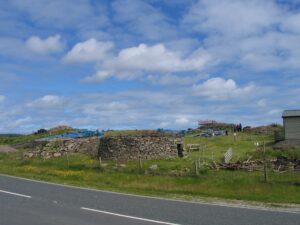
There is always great interest in any excavation that takes place in Orkney. There will be coverage on local radio and in the papers, and it is likely that any Open Day will be popular, together with a steady stream of visitors at other times. Nevertheless, there is, it seems, often a disjuncture between the public idea of the likely outcomes of excavation and the archaeologically desired outcomes of a dig.
As archaeologists we usually dig for two, sometimes interrelated, reasons. We dig when a significant site is about to be destroyed by development or unavoidable erosion. And we dig when we have serious research questions about a site that can only be answered by excavation. The ideal outcome for the archaeologist will be information, presented perhaps in the form of a book, academic report or internet paper. This might, hopefully, be supplemented in the popular media. It makes its way into received wisdom and student lectures. Job Done.
Yet, if you talk to the public about any site, you will often find an assumption that the site is being excavated with a view to laying it out and creating a new visitor experience. This is particularly the case for projects with a higher public profile, and in areas such as Orkney where archaeology is an important part of the local economy.
The sad reality is that the costs and exigencies of laying out a site as a heritage attraction today mean that it is less likely to be undertaken now than it was in the heady days of the early twentieth century when the old Ministry of Works was newly formed and enthusiastically building up its estates. New sites are still created on occasion, but while they provide excellent additions to the local repertoire of visitor experiences, in all too many cases the problems of annual maintenance and/or upkeep of infrastructure become all too visible after a few years. The wonderful Archaeolink Centre outside Aberdeen closed a few years ago now, leaving its recreations of Iron Age roundhouses and Roman earthworks to form a new type of 21st century archaeology. In Shetland, the restoration of Old Scatness broch and associated structures (some built from new), has demanded constant maintenance against the fracturing of stonework once more exposed to the harsh northern climate and the onset of thriving weed colonies.
Even where there is both finance and expertise, the paperwork necessary to complete planning and health and safety regulations (among the many necessary constraints), make the process of opening a new attraction painfully slow. In many cases the very interest of an archaeological site means, ironically, that there are additional constraints in order to preserve the heritage value and setting of any particular site, as in a World Heritage Area.
Those who visit sites like the Ness of Brodgar or The Cairns in Orkney may imagine themselves returning at some future date to a manicured heritage site not unlike the Historic Environment Scotland sites that form such an important feature of any visit to Orkney. In truth this is unlikely to happen. It is not something that has previously bothered me much because the Mesolithic sites that I have always worked on are never going to provide significant visitor attractions (though I do occasionally dream of museums such as The Vedbæk Finds Museum in the vicinity of the Vedbæk site in the north of Copenhagen). But now I am left with a slight feeling of unease that while we are working hard to build an audience for archaeological fieldwork, we are not working to meet their aspirations.
I’m not sure what the answer is. More information certainly. More openness. A shift in our information away from the joys of uncovering material to some of the more practical aspects of studying and presenting it, of long-term maintenance. In general, I find that people are interested in the issues that surround the future of any archaeological site. Where not dictated by the situation (destruction in advance of a supermarket, road, or housing development for example), discussion of the problems of car parks, staffing, display decisions, and long-term welfare provide a fascinating insight into heritage management that many people are keen to obtain.
As an archaeologist I have always focused on the generation of academic knowledge from excavations. I have come to realise recently that this might not be the sole goal. I’ve had to broaden my horizons to consider other outputs, fulfilling the needs of a wider audience.
You must be logged in to post a comment.